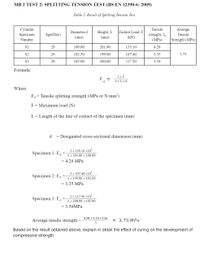
Structural Analysis
6th Edition
ISBN: 9781337630931
Author: KASSIMALI, Aslam.
Publisher: Cengage,
expand_more
expand_more
format_list_bulleted
Question

Transcribed Image Text:MB 2 TEST 2: SPLITTING TENSION TEST (BS EN 12390-6: 2009)
Table 2. Result of Splitting Tension Test
Cylinder
Specimen
Tensile
Average
Tensile
Diameter,d
Height, L
Failure Load, F
Age(Day)
strength, f4
(mm)
(mm)
(kN)
Number
(MPa)
Strength (MPa)
s1
28
100.00
201.00
135.10
4.28
S2
28
102.50
199.00
107.40
3.35
3.73
S3
28
105.00
200.00
117.50
3.56
Formula:
2 x F
F
ct
пxLxd
Where
Fa= Tensile splitting strength (MPa or N/mm?)
F = Maximum load (N)
L = Length of the line of contact of the specimen (mm)
d.
= Designated cross-sectional dimension (mm)
2 x 135.10 x10
Specimen 1: Fet
I x 201.00 x 100.00
= 4.28 MPa
2 x 107.40 x10
πx 199.00 x 102.50
Specimen 2: Fea
= 3.35 MPa
2x 117.50 x10
Specimen 3: Ft =
TE x 200.00 x 105.00
= 3.56MPA
4.28 +3.35+3.56
Average tensile strength
= 3.73 MPa
%3D
3
Based on the result obtained above, explain in detail the effect of curing on the development of
compressive strength.
Expert Solution
This question has been solved!
Explore an expertly crafted, step-by-step solution for a thorough understanding of key concepts.
Step by stepSolved in 2 steps

Knowledge Booster
Learn more about
Need a deep-dive on the concept behind this application? Look no further. Learn more about this topic, civil-engineering and related others by exploring similar questions and additional content below.Similar questions
- A compact tension specimen is tested according to ASTM standard E399. The load displacement curve is shown in the Figure below with PQ= 120 kN (Type 1 curve). The specimen dimensions are B=0.5 cm, W=10 cm, and “a” =5 cm. If the materials yield stress is 600 MPa are the conditions correct for a valid K1C measurement? Please look up McEviley’s textbook on the thickness criterion for a valid fracture toughness value.arrow_forwardA concrete cylinder sample has a diameter of 6 inches and a height of 12 inches. The maximum load carried by the sample after its failure is 500 KN. Determine the compressive strength of the sample in psi. (use 1lbf = 4.45 N, round-up your answer to the nearest whole number that is divisible by 5, no need for unit)arrow_forwardWhat value of uniformly distributed live load w is required to produce initial cracking of the U- shaped cantilever beam shown in the figure below. The beam is constructed of normal weight concretewith f' 25MPaand f 420MPa.arrow_forward
- If the specimen is originally square and has dimensions of a = 4 in., b = 3 in., and a thickness of t = 0.4 in., determine its new dimension a' after the load is applied. Express your answer to six significant figures and include appropriate units. a' = 4.00737 μA Submit Previous Answers Request Answer Part B X Incorrect; Try Again; 5 attempts remaining 0 in Determine its new dimension b' after the load is applied. Express your answer to six significant figures and include appropriate units. μᾶ b= 3.00333 ? in Submit Previous Answers Request Answer ? X Incorrect; Try Again; 5 attempts remainingarrow_forwardHow do I find the specimen’s final length and diameterarrow_forward
arrow_back_ios
arrow_forward_ios
Recommended textbooks for you

 Structural Analysis (10th Edition)Civil EngineeringISBN:9780134610672Author:Russell C. HibbelerPublisher:PEARSON
Structural Analysis (10th Edition)Civil EngineeringISBN:9780134610672Author:Russell C. HibbelerPublisher:PEARSON Principles of Foundation Engineering (MindTap Cou...Civil EngineeringISBN:9781337705028Author:Braja M. Das, Nagaratnam SivakuganPublisher:Cengage Learning
Principles of Foundation Engineering (MindTap Cou...Civil EngineeringISBN:9781337705028Author:Braja M. Das, Nagaratnam SivakuganPublisher:Cengage Learning Fundamentals of Structural AnalysisCivil EngineeringISBN:9780073398006Author:Kenneth M. Leet Emeritus, Chia-Ming Uang, Joel LanningPublisher:McGraw-Hill Education
Fundamentals of Structural AnalysisCivil EngineeringISBN:9780073398006Author:Kenneth M. Leet Emeritus, Chia-Ming Uang, Joel LanningPublisher:McGraw-Hill Education
 Traffic and Highway EngineeringCivil EngineeringISBN:9781305156241Author:Garber, Nicholas J.Publisher:Cengage Learning
Traffic and Highway EngineeringCivil EngineeringISBN:9781305156241Author:Garber, Nicholas J.Publisher:Cengage Learning


Structural Analysis (10th Edition)
Civil Engineering
ISBN:9780134610672
Author:Russell C. Hibbeler
Publisher:PEARSON

Principles of Foundation Engineering (MindTap Cou...
Civil Engineering
ISBN:9781337705028
Author:Braja M. Das, Nagaratnam Sivakugan
Publisher:Cengage Learning

Fundamentals of Structural Analysis
Civil Engineering
ISBN:9780073398006
Author:Kenneth M. Leet Emeritus, Chia-Ming Uang, Joel Lanning
Publisher:McGraw-Hill Education


Traffic and Highway Engineering
Civil Engineering
ISBN:9781305156241
Author:Garber, Nicholas J.
Publisher:Cengage Learning